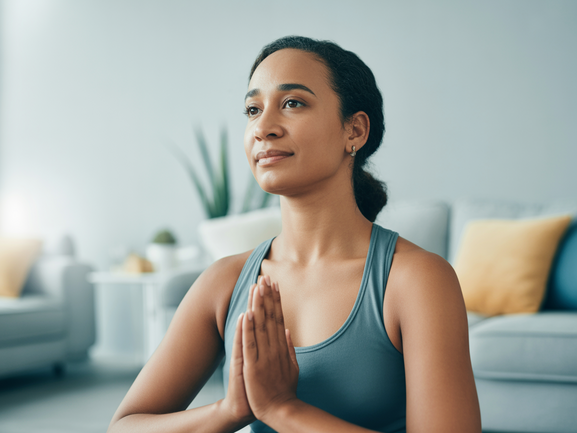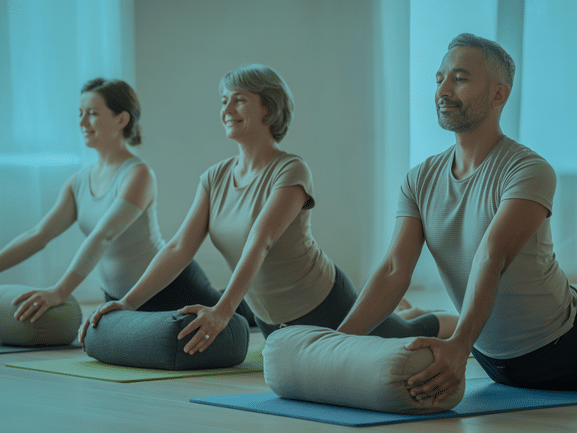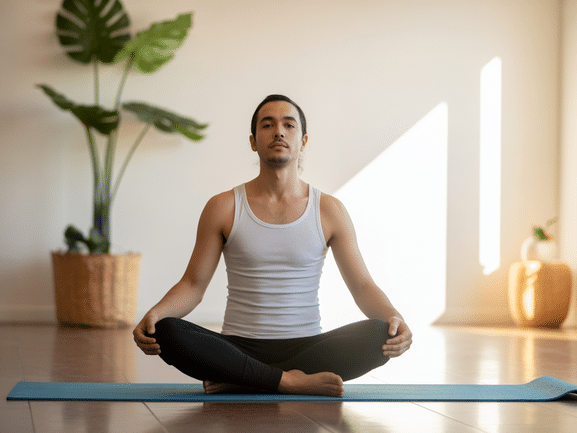Yoga for Chronic Pain: A Guide to Relief and Empowerment
Living with chronic pain is a daily battle that demands immense strength and resilience. It’s a journey where some days feel overwhelming, but it’s crucial to remember: you are not defined by your pain. This guide explores how the gentle practice of yoga for chronic pain can become your most powerful ally, offering a path to relief, empowerment, and a renewed connection with your body.
We believe in a holistic approach to wellness. Here, we’ll delve into the science behind yoga for pain management, share practical steps to start safely, and provide the encouragement you need to begin this transformative journey. Your path to a more comfortable life starts now.
Understanding Chronic Pain and Its Impact
Chronic pain is defined as pain that persists for more than three months. Unlike acute pain—a temporary signal of injury—chronic pain is a constant presence that can stem from an old injury, an ongoing condition like arthritis, or sometimes, no clear cause at all. This relentless condition profoundly affects physical and mental well-being, often leading to stress, anxiety, and depression.
Effective management requires a multi-faceted approach that addresses both body and mind. This is precisely where practices like yoga for chronic pain excel, by creating a synergy between physical movement, mindful breathing, and mental fortitude.

The Science: How Yoga for Chronic Pain Rewires Your Brain and Body
Yoga is far more than just stretching. It is a sophisticated mind-body practice validated by science for its remarkable effects on the nervous system and pain perception. Research from institutions like the National Center for Complementary and Integrative Health confirms its efficacy. A 2024 study published in the *Journal of Pain Research* also found that consistent yoga practice can lower cortisol levels and reduce inflammatory markers associated with chronic pain.
Key Mechanisms of Pain Relief:
- Neuroplasticity and Pain Perception: Yoga and meditation can change the structure of your brain. It strengthens the prefrontal cortex, which helps regulate emotions and pain, while calming the amygdala, the brain’s fear center. This helps you change your relationship with pain, reducing its emotional toll.
- Parasympathetic Activation: Deep, controlled breathing (pranayama) is a core component of yoga for pain management. It activates the parasympathetic nervous system, shifting your body from a state of high-alert stress (‘fight or flight’) to one of ‘rest and digest,’ promoting healing and recovery.
- Endorphin Release: Gentle movement stimulates the release of endorphins, your body’s natural painkillers. This creates a sense of well-being and provides immediate, natural relief.
- Reduced Inflammation: Slow, mindful stretching improves circulation and lymphatic drainage, which helps reduce inflammation—a primary driver of many chronic pain conditions.
Choosing the Right Yoga Style for Your Needs
Not all yoga is created equal, especially when dealing with chronic pain. Opting for a gentle, supportive style is crucial for a safe and effective practice. Here’s a comparison to help you choose the best fit for your journey with yoga for chronic pain.
| Yoga Style | Description | Best For |
|---|---|---|
| Restorative Yoga | A passive practice using props like blankets and bolsters to fully support the body in restful poses. | High pain levels, fatigue, stress reduction, and deep nervous system relaxation. |
| Yin Yoga | A slow-paced style where seated poses are held for several minutes to target deep connective tissues and joints. | Improving flexibility, joint mobility, and releasing deep-seated tension. |
| Gentle Hatha | Focuses on foundational poses at a comfortable pace, with an emphasis on proper alignment and breath. | Beginners, building foundational strength, and improving body awareness. |
| Chair Yoga | A modified practice where poses are performed while seated or using a chair for support. | Limited mobility, balance issues, or those unable to get on the floor. |
Ready to Transform Your Pain Journey?
Discover guided yoga and meditation sessions designed for your needs. The Vitalizen App is your companion for gentle, effective pain management, right from the comfort of your home.
How to Start Practicing Yoga Safely: A 4-Step Guide
Taking that first step can feel daunting, but with the right approach, you can build a safe and sustainable practice. Follow these steps to begin your journey with yoga for chronic pain.
Step 1: Consult Your Healthcare Provider
Before beginning any new physical regimen, it’s crucial to speak with your doctor or physical therapist. Discuss your interest in yoga for pain management to ensure it aligns with your specific condition and treatment plan. They can offer personalized recommendations and precautions.
Step 2: Find a Qualified Instructor or App
Seek out a yoga instructor with experience in therapeutic yoga or working with chronic pain. Alternatively, a specialized app like Vitalizen provides curated, guided sessions designed for pain relief, offering clear instructions and modifications you can use anytime, anywhere.
Step 3: Master the Golden Rule: Listen to Your Body
This is the most important principle in yoga for chronic pain. Never push through sharp, shooting, or intense pain. Learn to differentiate between the discomfort of a gentle stretch and a signal of harm. The motto is ‘no pain, no pain’—not ‘no pain, no gain’.
Step 4: Start Small and Be Consistent
Consistency trumps intensity. Begin with short sessions of 10-15 minutes, 3-4 times a week. Even a few minutes of daily mindful breathing and gentle movement can have a more profound impact than one long, infrequent session. Celebrate your commitment, not the duration.
💡 Tip: Create a calming space for your practice. A quiet corner, a comfortable mat, and perhaps some soft lighting can signal to your brain that it’s time to relax and heal. Explore our resources on creating a mindful space.
10 Inspirational Quotes to Support Your Healing Journey
Mental resilience is a key part of managing chronic pain. Let these words be a source of comfort and strength. Return to them whenever you need a reminder of the warrior within you.
- “You are not your pain. You are the warrior who is fighting it every single day.”
- “The strongest people are not those who show strength in front of us but those who win battles we know nothing about.”
- “Healing is not a destination, but a journey. And every small step forward is a victory worth celebrating.”
- “Breathe through it. This moment is not your forever.” – A powerful mantra for meditation for chronic illness.
- “Your body is not a cage, but a garden. Tend to it with kindness, patience, and gentle care.”
- “This pain is part of my story, but it does not get to write the ending. I am the author of my life.”
- “Allow yourself to feel. Allow yourself to heal. Allow yourself to be exactly where you are.”
- “Even on the darkest days, the sun is still shining behind the clouds. Your inner light is never extinguished.”
- “One day you will tell your story of how you overcame what you went through and it will be someone else’s survival guide.” – Brené Brown
- “Out of suffering have emerged the strongest souls; the most massive characters are seared with scars.” – Kahlil Gibran
For more daily inspiration, you can check authoritative sources like Goodreads for motivational quotes.
Frequently Asked Questions (FAQ)
Can yoga really help with chronic pain?
Absolutely. Yoga for chronic pain is a highly recommended, evidence-based practice. Its focus on gentle stretching, mindful breathing, and stress reduction helps decrease pain perception, reduce inflammation, and improve overall physical and mental well-being. It empowers you to take an active role in your healing.
What type of yoga is best for chronic pain sufferers?
Gentle and restorative styles are ideal. Look for classes labeled as Restorative Yoga, Yin Yoga, Gentle Hatha, or Chair Yoga. These styles use props to support the body, allowing for deep relaxation without strain. The Vitalizen App offers curated sessions specifically for pain relief.
Is it safe to practice yoga with my condition?
For most people, yes, as long as it is approached with care and after consulting a doctor. It is essential to listen to your body and never push into sharp pain. A great starting point is an app like Vitalizen, which provides clear modifications and guidance for a safe home practice.
How often should I practice yoga for pain relief?
Consistency is more important than intensity. Starting with 15-20 minutes, 3-4 times a week, can make a significant difference. A short, daily practice of gentle stretching and breathing can be more beneficial than one long, infrequent session. Find a rhythm that feels good for your body.
Will I need any special equipment?
Not necessarily to start. A comfortable space is all you need. However, some props can enhance your practice of yoga for chronic pain. Common household items like pillows, blankets, and books can substitute for yoga bolsters and blocks. A yoga mat can provide cushioning and grip.
Your Path to a More Comfortable and Empowered Life
Living with chronic pain is a testament to your incredible strength. By integrating mindful practices like yoga for chronic pain and powerful healing affirmations into your daily life, you can reclaim your power, reduce your symptoms, and transform your relationship with your body. You are not alone on this journey.
If you have more questions or want to share your story, please don’t hesitate to contact us. We are here to support you. Welcome to the Vitalizen.app | Yoga e meditação community.



